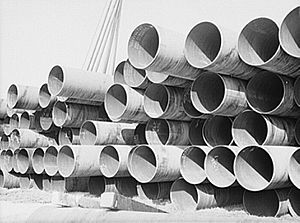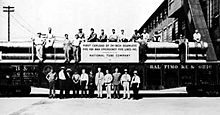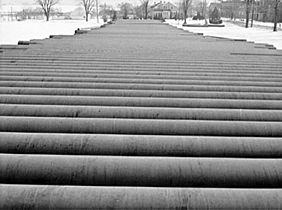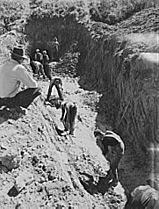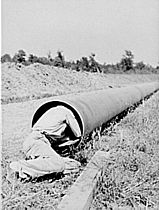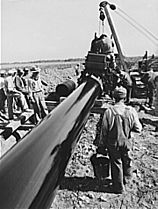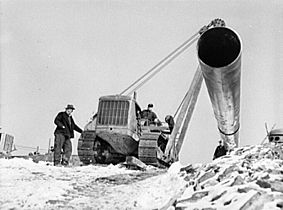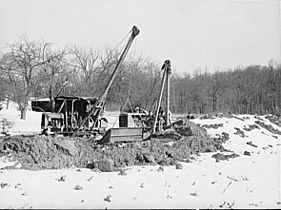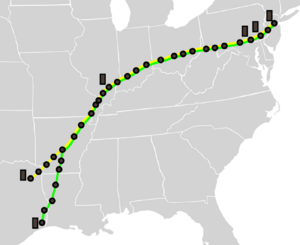Big Inch facts for kids
Quick facts for kids Big and Little Inch pipelines |
|
|---|---|
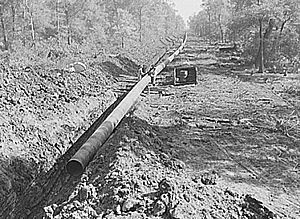
Big Inch pipeline being laid, 1942
|
|
| Location | |
| Country | United States |
| General information | |
| Type | Oil, natural gas |
| Owner | Spectra Energy, Enterprise Products |
| Construction started | 1942, 1943 |
| Technical information | |
| Diameter | 20–24 in (508–610 mm) |
| No. of pumping stations | 28, 7 |
The Big Inch and Little Big Inch are two very long pipelines that stretch from Texas to New Jersey. They were built quickly between 1942 and 1944 during World War II in the United States.
Before the war, oil was mostly shipped from Texas to the northeastern states by oil tankers. But after the U.S. joined the war in 1942, German submarines began attacking these ships. This made it hard to get oil to the East Coast and to Great Britain. To solve this problem, Harold L. Ickes, who was in charge of the country's resources, suggested building pipelines on land. This would be a safer way to move oil.
The U.S. government paid for these pipelines. They were built and run by a special company called War Emergency Pipelines. This company was a non-profit group supported by big American oil companies. The Big Inch pipeline was 1,254 miles (2,018 kilometres) long, and the Little Big Inch was 1,475 miles (2,374 kilometres) long. They were the longest and biggest pipelines ever built at that time. The project needed 16,000 workers and a huge amount of materials. It was seen as a great example of how the government and private companies could work together during the war.
After the war ended, people debated what to do with the pipelines. In 1947, the Texas East Transmission Corporation bought them. They changed the pipelines to carry natural gas, which completely changed how energy was supplied in the Northeast. The Little Big Inch went back to carrying oil in 1957. Today, parts of these pipelines are still used by Spectra Energy Partners and Enterprise Products.
Contents
Why Were These Pipelines Built?
By the time the United States entered World War II in 1941, oil was super important for military actions around the world. The U.S. produced 60% of the world's crude oil. Most of this oil came from Texas.
The northeastern U.S. depended on this oil. It was usually moved from Texas to the East Coast by ships or trains. In early 1941, about 70,000 barrels of oil were moved by train each day. But trains were expensive. Most oil traveled by large barges along rivers and the Atlantic Coast.
When the war started, German U-boat submarines attacked ships along the eastern coast. The U.S. Navy was not ready for this. Between January and April 1942, 46 oil tankers were sunk and 16 were damaged. This problem got worse because 50 tankers had been sent to help the UK earlier. Insurance companies started refusing to cover the remaining ships. The amount of oil reaching the Northeast from Texas dropped a lot.
To fix this, the Navy stopped tankers from using the northeastern sea routes in April 1942. The government and oil companies tried to use trains more. They increased the amount of oil carried by trains by more than ten times. But there weren't enough train cars, and many were in bad shape. So, the U.S. government started looking at pipelines as a way to get oil to the Northeast.
How the Idea Came to Life
Moving oil by pipeline from the Southwest to the Northeast was a good idea. Pipelines would be safe from submarine attacks and could work in any weather. Pipelines had been used since 1862. But by the 1930s, most were only 8 inches (200 mm) wide and could move 20,000 barrels of oil a day. Larger pipes were hard to build and couldn't handle high pressure. New ways to build bigger, stronger pipes appeared before the war, but they were too expensive for regular business.
The idea for such a pipeline was first suggested in 1940 by Harold L. Ickes. He said that while a pipeline might not make money normally, it would be "absolutely necessary" in an emergency. A group of oil companies tried to build one in 1941. But the government worried about how much steel it would need.
In 1941, Ickes became the Petroleum Coordinator for National Defense. New laws were passed to allow pipelines to be built for the war effort. This included letting the government buy land for the pipelines, even if owners didn't want to sell.
Planning for the Inch pipelines started in May 1941. An aerial survey was done to find the best route. A first design was ready by September. But the government still wouldn't approve the steel needed. After the war started and ships were attacked, oil companies met again in March 1942. They came up with a new plan called the Tulsa Plan, which included the Inch pipelines. The steel was finally approved on June 10.
The government provided $35 million to start the project. The actual building and running of the pipelines were done by the War Emergency Pipelines company (WEP). This was a non-profit group made up of the biggest oil companies in the U.S. The WEP was led by Burt Hull and W. Alton Jones, who were experts in the oil business.
Building the Giant Pipelines
The Inch pipelines were two separate systems. The Big Inch was a 24-inch (610 mm) pipeline for crude oil. It ran from Longview, Texas, to Norris City, Illinois. Then it went to Phoenixville, Pennsylvania, where it split into 20-inch-diameter (510 mm) pipes. One went to New York and ended in Linden, New Jersey. The other went to Philadelphia and ended in Chester Junction, Pennsylvania.
The Little Big Inch was a 20-inch-diameter (510 mm) pipeline for refined oil products like gasoline. It ran from Beaumont, Texas, to Little Rock, Arkansas. From there, it followed the same path as the Big Inch to New Jersey and Pennsylvania.
This pipeline project was the longest, biggest, and heaviest of its kind in the world. The Big Inch was 1,254 miles (2,018 km) long, with extra smaller lines. It had 28 pumping stations about every 50 miles (80 km). The Little Big Inch was 1,475 miles (2,374 km) long, with its own extra lines and seven unique pumping stations at its start.
Many companies worked on the project, hiring over 16,000 people. The government had to get permission to build across 7,500 pieces of land. In 300 cases, they had to use a special right to buy the land. The pipelines were soon called "Big Inch" and "Little Big Inch" because of their huge size. The construction was shown in newsreels and films as part of the U.S. war effort.
The Big Inch pipe sections were 24-inch (61 cm) wide, up to 44 feet (13 m) long, and weighed 4,200 pounds (1,900 kg). The Little Big Inch used slightly thinner pipes. In total, 21,185 train car loads of steel pipe were used.
Workers dug trenches 4 feet (1.2 m) deep and Template:3 wide. They used machines and hand tools. The pipes were cleaned inside and then welded together. Sometimes, workers moved around the pipes to weld them. Other times, the pipes were rotated so the welder could stay in one spot. If the pipeline needed to curve, the steel pipes were bent using special methods.
To protect the pipes from rust, they were cleaned, painted with tar, and wrapped in asbestos felt. Then, the heavy pipes were carefully lowered into the trenches. Large tractors were needed to lift them. Finally, the trenches were filled back in.
The Big Inch pipeline had to go under 33 rivers, 200 creeks and lakes, and hundreds of roads and railroad tracks. Special tunnels were dug for roads and railroads. Trenches were dug under rivers and lakes, and the pipes were weighted down so they wouldn't float. About 4 miles (6.4 km) of pipe were laid underwater.
The pumping stations were built on large plots of land. The buildings were simple, made of steel or wood. The whole project needed 725,000 short tons (658,000 t) of materials.
Work started on June 26, 1942. The Big Inch was built in two parts: first to Norris City, Illinois, then extended to Phoenixville, Pennsylvania. After the Big Inch was done, work began on the Little Big Inch.
The first order for pipe was placed on July 2, 1942. Pipe laying began on August 3, 1942. Eight crews, each with 300 to 400 men, worked on different sections. They aimed to lay 5 miles (8.0 km) of pipe each day, but sometimes laid as much as 9 miles (14 km). Oil started flowing through the Big Inch between Texas and Illinois on New Year's Eve 1942. The Little Big Inch was finished in March 1944.
The Big Inch could carry over 334,000 barrels of crude oil a day. The Little Big Inch carried almost 240,000 barrels of gasoline daily. These pipelines used a lot of electricity to pump the oil.
Construction process, recorded by John Vachon
What Happened After the War?
After the war, there was a big discussion about what to do with the pipelines. Large oil companies wanted to change them to carry natural gas. Engineers also suggested using them for natural gas. There was a growing demand for natural gas, and lots of it was available in Texas. But it couldn't easily get to the Northeast.
However, railroad and coal companies were against this idea. They thought it would create more competition and lower the demand for their own goods. Smaller oil companies wanted the pipelines to keep carrying oil. They hoped this would help them compete with the bigger oil companies.
The government held an investigation to decide the pipelines' future. Many groups shared their opinions. The investigation first decided that the pipelines should be sold to continue carrying oil. An auction was held in 1946. Companies that wanted to move oil were given special preference. But the highest offers came from companies wanting to use them for natural gas.
The decision became complicated and involved national politics. Meanwhile, a possible national coal strike made people worry about energy supplies. This made the idea of using natural gas pipelines seem even better.
A new auction was held. This time, bids for natural gas were considered equal to bids for oil. On February 8, 1947, the Texas East Transmission Corporation (TETCO) won the auction. Their bid of $143,127,000 was the largest sale of war property to a private company after World War II.
Changing to Natural Gas
TETCO was a new company created just to buy these pipelines. They believed they could afford their high offer because they planned to reuse the electric motors from the oil pumps for natural gas. They also thought the price of natural gas would go up a lot after the war.
After winning, TETCO raised money by selling bonds and shares. Another government review was needed before the sale could go through. The state of Pennsylvania was hesitant to allow gas to be pumped through its territory. The coal industry in Pennsylvania worried about losing sales. But eventually, Pennsylvania agreed, and the sale to TETCO was completed on November 1. The company's value quickly increased a lot.
TETCO immediately started changing the pipelines to carry natural gas. They built 24 compressor stations along the pipelines. These stations used centrifugal compressors to increase the amount of gas the system could carry to 433,000,000 cubic feet (12,300,000 m3) a day. The old oil pumps were kept in case they were needed again in an emergency. Strong steel valves replaced older, less reliable ones. Demand for gas kept growing, and by January 1949, the pipelines were moving 508,000,000 cubic feet (14,400,000 m3) of gas a day.
This new gas supply changed the energy market in the Northeast. Many major cities quickly switched to using natural gas. The Inch pipelines helped lead to the building of many more long-distance pipelines across the U.S. in the 1960s and 1970s.
The Pipelines Today
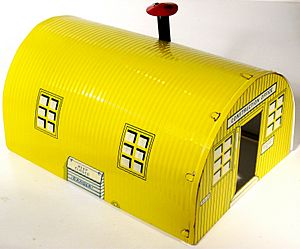
In 1957, the Little Big Inch was changed back to carrying oil products. This part of the pipeline was then owned by Texas Eastern Petroleum Products Corporation (TEPPCO). TEPPCO was later bought by Enterprise Products in 2010. Around 1961, there was talk of changing the Big Inch back to oil use, but it stayed a gas pipeline. Today, parts of the pipelines are owned by Spectra Energy Partners and Enterprise Products.
The Inch pipelines are listed on the National Register of Historic Places. This means they are recognized as important historical sites. In the western parts of the pipelines, about 90% of the pipes are still the original ones. But in the east, many parts have been replaced because the original pipes didn't have good protection against rust. 62 of the original buildings from 1942 and 1943 are still standing. These include pump-houses, offices, and garages. The best examples of these old buildings are in Pennsylvania. A "Big Inch pipeline" construction toy set was even made for children in 1962 by the Marx company.
Pumping Stations Along the Way
Big Inch and northern Little Big Inch
- Station No. 1: Longview, Texas
- Station No. 2: Atlanta, Texas
- Station No. 3: Hope, Arkansas
- Station No. 4: Donaldson, Arkansas
- Station No. 5: Little Rock, Arkansas
- Station No. 6: Bald Knob, Arkansas
- Station No. 7: Egypt, Arkansas
- Station No. 8: Fagus, Missouri
- Station No. 9-a: Oran, Missouri
- Station No. 9-b: Gale, Illinois
- Station No. 10: Lick Creek, Illinois
- Station No. 11: Norris City, Illinois
- Station No. 12: Princeton, Indiana
- Station No. 13: French Lick, Indiana
- Station No. 14: Seymour, Indiana
- Station No. 15: Oldenburg, Indiana
- Station No. 16: Lebanon, Ohio
- Station No. 17: Circleville, Ohio
- Station No. 18: Crooksville, Ohio
- Station No. 19: Sarahsville, Ohio
- Station No. 20: Wind Ridge, Pennsylvania
- Station No. 21: Connellsville, Pennsylvania
- Station No. 22: Rockwood, Pennsylvania
- Station No. 23: Chambersburg, Pennsylvania
- Station No. 24: Marietta, Pennsylvania
- Station No. 25: Phoenixville, Pennsylvania
- Station No. 26: Lambertville, New Jersey
- Station No. 27: Linden, New Jersey
Southern part of the Little Big Inch
- Station A: Baytown, Texas
- Station B: Beaumont, Texas
- Station C: Newton, Texas
- Station D: Many, Louisiana
- Station E: Castor, Louisiana
- Station F: El Dorado, Arkansas
- Station G: Fordyce, Arkansas
See also
 In Spanish: Big Inch para niños
In Spanish: Big Inch para niños



